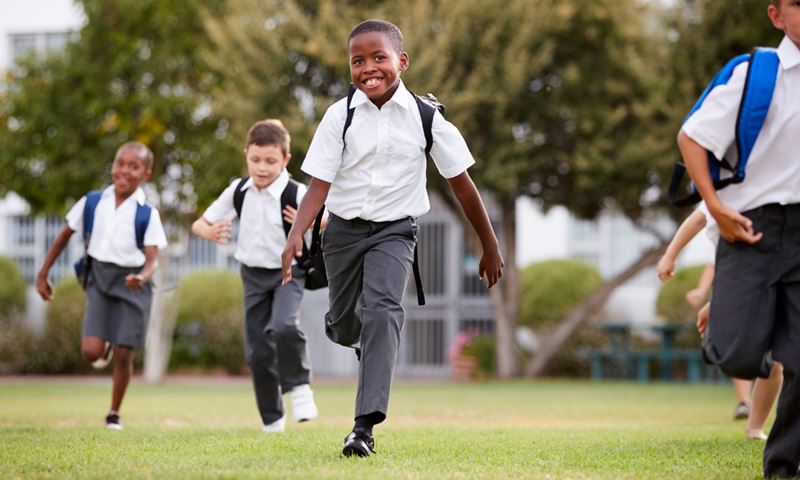Published 01 Feb 2024
The holiday is over and by now, uniforms have been fitted, hair has been cut and bags packed. The back-to-school checklist is long, but in case you overlooked these in the last-minute rush to get to the gates, we highlight eight important points for your child’s health and wellbeing throughout the school year.
1. Make sure they’re getting enough sleep
Routines often go out the window over the holidays and the return to school can be a shock to the system. Sleep is essential to the healthy growth and brain function of children, supports immunity and recovery from illness and helps students stay focused in school. As you ease back into the school year, it is important to make sure that kids are getting the recommended amount of good-quality, uninterrupted sleep each night, which is:
- 9 to 11 hours for children aged 5 to 13 years
- 8 to 10 hours for young people aged 14 to 17 years
Some tips for getting back on track with sleep include:
- serving evening meals at the same time each night
- encouraging regular exercise
- re-establishing a bedtime routine
- maintaining consistent bedtime and wake-up times
- creating a calming space for sleep
- avoiding stimulants such as tea or sports drinks in the afternoon
- avoiding screens up to one hour before bedtime
- keeping bedrooms screen-free
2. Book in for an eye check
A child’s eyesight plays a large role in their education, whether through reading the teacher’s notes on the board or screen, writing and other ‘near-work’ activities, following the ball on the sports field or simply navigating the school environment. Detecting any issues early-on is crucial for avoiding vision-related learning delays as well as impacts on a child’s confidence and social interactions at school. Many children do not know that they have an issue with their eyesight as it’s all they’ve ever known, making it harder for parents and carers to detect.
GMHBA Eye Care optometrist Andrew Varga says that some signs of poor vision in kids can include:
- holding things close to their face, or preferring to sit close to the board, television or teacher
- squinting to see objects in the distance
- disinterest in or delayed reading
- difficulty catching balls or general clumsiness
- symptoms of tiredness, particularly after reading, drawing or concentrating on visual activities
- frequent headaches
Book in with one of our friendly optometrists to check your child’s vision and learn more about why an annual eye test should be part of every child’s back to school routine.
3. Check their feet
It’s important for growing feet to have properly fitting shoes, particularly school shoes which they spend so much time in! Children's feet can keep growing until around 20 years of age, and as a rule of thumb, it’s good to check that their shoes fit at the start of each school term. Feet can swell throughout the day, so it’s best to do a fit check at the end of the day when the child’s foot is at its largest. Make sure that they have a comfortable fit (length and width) and there is around 1cm of growing room for the big toe. Shoes should have a firm heel counter to hold the foot in place and give support around the ankle.
Signs of ill-fitting shoes may include:
- uneven wear on the heels of shoes
- limping or a sudden change in your child’s gait (their manner of walking)
- pain in the feet or legs, particularly after being on the feet for some time
- frequent tripping or perceived clumsiness on feet
Have your child’s next pair of shoes fitted professionally and if you have any concerns about your child’s foot health, speak to a podiatrist.
4. Select an appropriate backpack
Lunchboxes, drink bottles, books, school supplies, spare clothes – kids pack a lot into their school bags. Choosing the right backpack and ensuring it is worn correctly is important for protecting developing bodies and making sure kids are comfortable on their way to and from school.
GMHBA physiotherapist Alessia Colombo, as aligned with advice from the Australian Physiotherapy Association (APA), advises to look out for these key features when selecting a backpack:
- endorsement from a professional organisation, such as the Australian Physiotherapy Association
- wide shoulder straps that sit comfortably on the shoulder
- adjustable chest and waist straps to help balance the load between the shoulder, hips and pelvis
- appropriateness for the child’s size (note: bigger is not always better and the bag should not extend higher than the child’s shoulders when sitting)
- a padded rear of the backpack to fit snugly against the child’s body
Typically, a school-issued or ‘uniform shop’ backpack will meet these requirements.
While it may be ‘cool’ to wear backpacks over one shoulder, remind your child that wearing the bag with both shoulder straps and a securely fastened waist strap will ensure that the weight is distributed appropriately and help to avoid the risk of injury.
5. Stay up to date with immunisations
Keeping up to date with your child’s immunisations from an early age will help to ensure that they – and the community – are protected from serious diseases.
Australian children are eligible to receive certain childhood vaccinations for free via the National Immunisation Program Schedule, and parents or guardians must provide the child’s immunisation history statement as part of their school enrolment process.
Free ‘catch-up’ immunisations (which refers to an immunisation given after the recommended date) are offered to all people under 20 years of age where they have missed these vaccines in childhood. Find out more about catch-up immunisations and the National Immunisation Program.
Annual influenza vaccinations are also recommended for everyone aged 6 months and older and the COVID-19 vaccine is available and recommended for children over 5.
Speak with your doctor or pharmacist about your child’s vaccination history and any upcoming travel to ensure that your family is protected not just at school, but also at home and overseas.
6. Encourage self-suffiency at school
Ensuring that your child can take care of some simple hygiene and care steps can not only boost their independence and confidence, but also help to stave off any nasties from the schoolyard.
Instil diligent handwashing practices at home and explain the importance of hand hygiene for reducing the spread of infection (at home or at school!)
Make sure that your child can apply their own sunscreen and remind them to protect uncovered skin before heading outside in terms 1 and 4, when UV is likely to be highest.
Pack a large drink bottle and encourage them to drink water throughout the day to stay hydrated.
7. Pack healthy lunchboxes
Lunchboxes: you either love or hate preparing them, but it’s important to make sure that your child has access to healthy options throughout the day to ensure that they are eating a balanced diet and getting essential nutrients and vitamins.
We spoke with nutritionist, dietitian and mum Joanna McMillian about building a healthy lunchbox and making meals that your whole family will eat. The Department of Health also has some great resources for lunchbox tips and recommends including one option from each of the five core food groups:
- Fruit – this can be fresh, frozen, pureed or canned in natural juice
- Vegetables, legumes and beans – many Australian schools now have a ‘fruit snack’ or ‘munch and crunch’ time set aside in their day to encourage kids to eat more fruit and vegetables
- Milk, yoghurt, cheese and alternatives
- Lean meats and poultry, fish, eggs, tofu, nuts and seeds, and legumes/beans – check your school’s policy on food restrictions as some schools ask that nuts, eggs, fish or soy are not packed in lunchboxes
- Grain (cereal) foods – opt for wholegrains where possible
Try to stick to water only in drink bottles to avoid additional sugar in their diet and set up healthy habits.
Involving your kids in the preparation of healthy foods to go in their lunchbox and packing it on the day can also increase the chance that they’ll eat it.
8. Make sure they’re getting enough physical activity
Most parents will tell you that their kids have a lot of energy to burn, and we know that exercise is important for people of all ages. Being active and involved in regular sports or other forms of physical exercise at an early age not only helps children to grow, improve their brain function and maintain a healthy weight, but also sets up healthy habits for life.
The Australian Institute of Health and Welfare and Australian Bureau of Statistics found that 2 in 3 (70%) children aged 2 to 17 do not meet the guidelines for physical activity in Australia and this has consequences for our children’s longer term physical and mental health and quality of life.
Once the dust has settled on the new school year, speak with your child about the physical activities that they enjoy and what they can get involved in throughout the year. They are many junior programs available in Australia for popular sports, including:
- Australian Rules football: Auskick
- Basketball: Aussie Hoops
- Netball: Net Set Go
- Cricket: Play Cricket
- Soccer: MiniRoos
- Swimming/beach safety: Nippers
Exercise doesn’t have to come in the form of organised sport, with walking the dog, riding a bike, dancing around the living room and helping with the gardening all counting as physical activity.
Have a listen to this GMHBA Healthier Together podcast, where we speak to registered teacher and psychologist Tim Dansie about how to support our kids in getting involved and enjoying sport.



